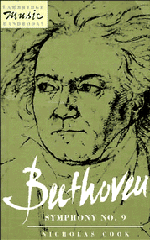Book contents
- Frontmatter
- Contents
- Preface
- 1 Sketches and myths
- 2 Early impressions
- 3 Performance and tradition
- 4 The Romantic Ninth
- 5 The twentieth-century Ninth
- Conclusion Beyond interpretation?
- Appendices
- 1 Schiller's ‘An die Freude’ and the Ninth Symphony
- 2 The text of the Ninth Symphony
- Notes
- Select bibliography
- Index
1 - Schiller's ‘An die Freude’ and the Ninth Symphony
Published online by Cambridge University Press: 08 January 2010
- Frontmatter
- Contents
- Preface
- 1 Sketches and myths
- 2 Early impressions
- 3 Performance and tradition
- 4 The Romantic Ninth
- 5 The twentieth-century Ninth
- Conclusion Beyond interpretation?
- Appendices
- 1 Schiller's ‘An die Freude’ and the Ninth Symphony
- 2 The text of the Ninth Symphony
- Notes
- Select bibliography
- Index
Summary
Beethoven seems to have had the setting of Friedrich Schiller's ‘An die Freude’ in mind throughout most of his life. Thayer quotes a letter written by Bartolomäus Fischenich in 1793 in which he mentions Beethoven's intention of setting ‘An die Freude’ (Thayer's Life, pp. 120–21), and there is some evidence that Beethoven actually did make a setting of it around 1798, though if so it has been lost; other notes relating to the text date from 1811–12 (Brandenburg, ‘Die Skizzen’, pp. 89–90).
Schiller originally wrote ‘An die Freude’ in 1785. But in 1803 he published a revised version in which some of the more explicitly political passages of the earlier version were toned down. Beethoven drew on the 1803 version for his Ninth Symphony, setting the first three verses and the first, third, and fourth choruses. He omitted those sections of the poem that turn it into an ‘elevated drinking song’, as Solomon puts it (Beethoven, p. 434). And he reorders the choruses in such a way that the initial picture of universal rejoicing (verses 1–3) is followed by the image of the hero speeding through the heavens (chorus 4); only after that does Beethoven introduce the choruses that depict the Creator beyond the stars (choruses 1, 3). In this way he creates a continuous line of development from the terrestrial to the divine.
Choruses 1 and 3 represent the spiritual kernel of Beethoven's setting, and after they first appear (bar 595) he uses only them and the first verse, sometimes in alternation, and at one point simultaneously (in the double fugue, bar 655).
- Type
- Chapter
- Information
- BeethovenSymphony No. 9, pp. 106 - 109Publisher: Cambridge University PressPrint publication year: 1993



